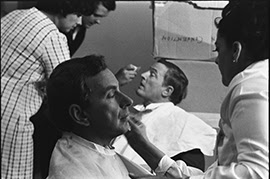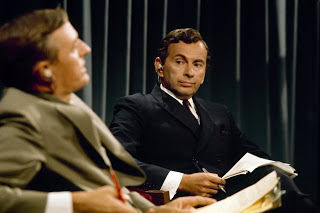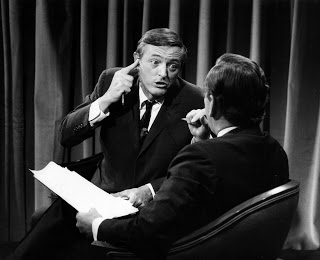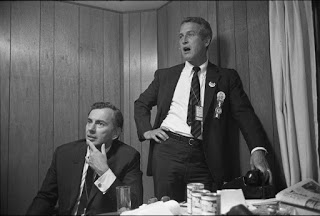‘Best of Enemies’ asks, ‘What have we unleashed?’
“The Best of Enemies” (2015). Interviews: Dick Cavett, Christopher Hitchens, Matt Tyrnauer, Sam Tanenhaus, Andrew Sullivan, George Merlis, John McWhorter, William Sheehan, Fred Kaplan, Reid Buckley, Linda Bridges, Ginia Bellafante. Voiceovers: Kelsey Grammer, John Lithgow. Archive Footage: William F. Buckley Jr., Gore Vidal, Howard K. Smith, Paul Newman, Arthur Miller, Sam Donaldson, Ted Koppel, Richard Nixon, Ronald Reagan, Gerald Ford, Robert Kennedy, Eugene McCarthy, Hubert Humphrey, Richard J. Daley, Norman Mailer, Patricia Buckley, Shana Alexander, James J. Kilpatrick, Dan Aykroyd, Jane Curtin. Directors: Robert Gordon and Morgan Neville. Screenplay: Robert Gordon and Morgan Neville. Movie web site. Filmmakers’ web site. Trailer.
At times we may look upon what we’ve manifested in our lives with shock, surprise and utter distress. Like a genie let loose from a bottle, these creations disrupt our realities in unimagined ways, causing havoc that takes our breath away – and that’s not easily remedied. Such instances often leave us unaware of how to proceed, too, largely because we’re overcome by what transpires. It’s conditions like these that become all too apparent in the provocative new historical documentary, “Best of Enemies.”
In 1968, the fortunes of the ABC television network were seriously flagging. As the lowest rated of the three networks, its numbers seriously trailed those of rivals NBC and CBS in both its entertainment and news programming. In fact, the network’s ratings were so dismal that TV industry insiders often joked that, if the country wanted to bring the Vietnam War to a quick conclusion, it should be broadcast on ABC, because it was sure to be cancelled after 13 weeks.
With such low ratings, the network’s ad revenues left something to be desired, too, which, consequently, affected its budgets and the quality of its programming. The news division felt the impact strongly, and, with the 1968 presidential conventions coming up, it was unclear how effective the network’s coverage would be. The traditional gavel-to-gavel approach used by NBC and CBS looked unworkable for ABC, so the network faced quite a coverage challenge. What it came up with would change television forever.
In lieu of the traditional convention broadcast format, ABC opted to do something different to set it apart from its competitors and attract a new crop of viewers. Instead of the gavel-to-gavel approach, the network decided to present a nightly 90-minute summary of each day’s activities at each convention. And, to distinguish its coverage even further, ABC came up with a novel idea: The news team decided to include a nightly segment offering an analysis of the day’s convention developments by two expert commentators, with one from each end of the political spectrum. ABC hoped these opposing viewpoints would prompt some spirited discussions, making for interesting, informative viewing. However, as events unfolded, the network quickly got more than what it bargained for.
Liberal political commentator Gore Vidal (foreground) and conservative pundit William F. Buckley Jr. (background) prepare to match wits in a series of heated televised debates during the 1968 presidential nominating conventions, the subject of the absorbing, wickedly funny new documentary, “Best of Enemies.” Photo courtesy of Magnolia Pictures.
To raise the profile of this innovative segment, ABC sought to recruit a pair of prominent experts, and, in doing so, it successfully engaged two eminent social and political commentators, conservative William F. Buckley Jr. (1925-2008) and liberal Gore Vidal (1925-2012). Buckley was well known as the founder of National Review magazine and host of the PBS television talk show Firing Line, as well as the author of numerous books. Vidal earned fame as the author of an array of novels and plays covering topics as diverse as politics and alternative life-styles, including the highly controversial works The City and the Pillar (1948) and Myra Breckenridge (1968).
Together, Buckley and Vidal were quite a pair. They had each become icons of their respective political and social outlooks, often serving as vociferous advocates (some might even say lightning rods) for their particular viewpoints. But, even more importantly, Buckley and Vidal seriously disliked each other, and ABC didn’t find out just how much until the broadcasts began.
The hoped-for spirited political discussions quickly degenerated into angry ideological screeds. During the Republican convention in Miami Beach, and even more so during the Democratic conclave in Chicago, an event marred by violent demonstrations in the streets of the Windy City, Buckley and Vidal went at each other like a pair of pit bulls. Very little of their televised discussions focused on politics or the events that transpired at the conventions. Instead, their segments became vehicles for shamelessly advancing conservative and liberal platforms. And, when neither commentator was able to successfully convey his particular ideological viewpoint to his debate opponent, Buckley and Vidal resorted to brazen insults, blatant name-calling and even threats of violence. ABC’s hopes of a lively but civil public affairs forum turned into a series of venomous personal attacks, verbal onslaughts that frequently left debate moderator and reserved ABC news anchor Howard K. Smith speechless.
Liberal political commentator Gore Vidal (right) and conservative pundit William F. Buckley Jr. (left) prepare to debate one another during ABC television’s inventive coverage of the 1968 presidential nominating conventions, as seen in the humorous but unsettling new documentary, “Best of Enemies.” Photo courtesy of Magnolia Pictures.
One might think that such highly public spectacles would be seen as embarrassing at best, appalling at worst. But, much to ABC’s surprise, the public ate up the debates, and the network’s ratings soared. Who would have thought?
“Best of Enemies” chronicles the foregoing in remarkable detail through an excellent assemblage of archive footage, including the debates themselves. This material is punctuated with clips from recent interviews with those who were involved in the broadcasts, such as former ABC News president William Sheehan and ABC convention coverage publicist George Merlis. Additional interviews feature conversations with prominent commentators, such as former TV talk show host Dick Cavett, former New Republic editor Andrew Sullivan, New York Times critic Ginia Bellafante, and the late literary and political analyst Christopher Hitchens. Further insights are provided by those who personally knew the debates’ combatants, including Buckley’s brother, Reid, his executive assistant, Linda Bridges, and his editor, Sam Tanenhaus, as well as Vidal’s editor, Matt Tyrnauer, and his biographer, Fred Kaplan.
Regardless of what one may have thought of the discussions-turned-debacles, they represented a broadcast innovation, and such explorations of the untried embody one of the hallmark principles of conscious creation, the means by which we create our reality through our thoughts, beliefs and intents. If you doubt that, consider the many copycat derivations and imitations that have arisen since the initial broadcast of the Buckley-Vidal debates. Perhaps the first of these was the “Point/Counterpoint” segment featuring liberal commentator Shana Alexander and conservative advocate James J. Kilpatrick on the television news magazine 60 Minutes. This immensely popular feature would later give birth to the free-for-all political discussions on the PBS series The McLaughlin Group. And in the wake of this video circus came all manner of animated cable TV news network pundits, many of whom regularly and zealously pummel one another with reckless abandon. Even the entertainment world got into the act with Saturday Night Live’s infamous parodies of the foregoing.
However, even if conscious creation maintains that we and all of our endeavors are continually evolving through the pursuit of our “constant state of becoming,” are such forays into the unexplored always necessarily desirable or beneficial? Consider the progeny of the Buckley-Vidal debates. Look at the heated ideological brow-beatings that regularly air on any number of today’s television networks, and ponder their merits. Do they really offer us anything? Indeed, has the dissemination of meaningful information been sacrificed for the sake of bombastic political theater?
Conservative pundit William F. Buckley Jr. (left) and liberal political commentator Gore Vidal (right, back to camera) hurl insults at one another during ABC television’s groundbreaking coverage of the 1968 presidential nominating conventions, as seen in the often-contentious new documentary, “Best of Enemies.” Photo courtesy of Magnolia Pictures.
Our power of creation is quite substantial, especially when we pool our efforts. Again, just look at the 1968 debates and how their impact has flourished in myriad forms since then. But, upon close scrutiny, these materializations remind us of the potency of our manifestation skills and the beliefs that underlie them, not to mention the responsibility that comes with all this.
In light of that, then, we must carefully assess our intents and what they’re being used to manifest. If we lose sight of that, though, we run the risk of birthing hideous abominations. Such ill-conceived creations can take on a life of their own, too, growing ever stronger and making it difficult, if not impossible, to let go of them when they’ve outlived whatever usefulness they might have had. Such was the case with Buckley and Vidal themselves after the broadcasts ended; their spiteful contentions and insults continued on in such highly public venues as Esquire magazine, with their virulent onslaughts against one another eventually leading to lawsuits that went on for years.
Sounds foolish, doesn’t it? Indeed, think of how all that energy got put to use – and the many other ways it might have been expended more productively.
To avoid such issues in the first place, it helps to identify what gave rise to them. In the case of the debates, Buckley and Vidal used the broadcast forum to further their respective ideologies. Prior to the debates, public awareness of their viewpoints was limited, restricted primarily to their core audiences of followers. However, with the national airwaves now available to them, they each had an opportunity to make the case for their particular agendas. And, while the stated purpose of their appearances was to comment on convention developments, they couldn’t resist the temptation to promote their own interests and attack their opponent.
Even though the debaters’ brands of conservatism and liberalism weren’t entirely unknown before the broadcasts, their televised appearances brought them into the national spotlight. Viewpoints that had been quietly simmering beneath the surface of the national consciousness for years were suddenly unleashed into the public domain. And, since these perspectives were diametrically opposed to one another, their advocates often disagreed, sometimes passionately, as evidenced by Buckley’s and Vidal’s televised diatribes.
But the debaters were not alone in their opinions; each represented a constituency that had at last found a spokesperson to represent its views. The clash of ideologies was thus born. With the emergence of two eloquent representatives who were ardent supporters of their particular outlooks and who greatly disliked one another personally, the embittered battle lines were clearly drawn – not just at the time of the broadcasts but for the future as well.
As one of the film’s commentators astutely observes, the issues that Buckley and Vidal raised during their debates – and the animosity they inflicted on one another – are the same as those we wrestle with today. In fact, as illustrated by the examples above, these conditions are even more prevalent (and nastier) today. But, if we want to see where everything started, we need only look back to these seminal broadcasts.
Liberal political commentator Gore Vidal (left) and actor Paul Newman (right), a delegate to the 1968 Democratic National Convention, look on in horror at television coverage of demonstrations in the streets of Chicago in the provocative new documentary, “Best of Enemies.” Photo courtesy of Magnolia Pictures.
A growing number of Americans have expressed increasing dissatisfaction with the ideological polarization that’s come to dominate national dialogues. It’s as if we’re becoming a people who speak the same language but are fundamentally incapable of communicating with one another. If we’re to find our way out of this mess, we need to recognize what we’ve created and how we brought it into being. Only then will we be able to take a step back, examine the beliefs that have wrought our present circumstances and consider how we might want to plot a new course for the future. In this regard, the experience of the Buckley-Vidal debates and what they birthed serves as a potent cautionary tale that we had better heed before it’s too late, no matter which side of the ideological fence one finds oneself on. It’s a lesson we can apply in any number of both public and private contexts, but it’s in our collective experience where attention is needed most – and fast.
“Best of Enemies” satisfies in so many ways. It’s an excellent documentary – informative, poignant, relevant and wickedly funny (though ultimately somewhat distressing). It features a great collection of interview footage and archive clips, both from the debates and the conventions, as well as from the protagonists’ lives outside these forums. Viewers witness scenes from their failed pre-debate political campaigns, as well as from their respective journalistic and literary works, such as Buckley’s Firing Line TV series and Vidal’s movies (those based on his books or for which he wrote the screenplays, including “The Best Man” (1964), “Ben-Hur” (1959), “Caligula” (1979) and “Myra Breckenridge” (1970)). The film also features narrated excerpts from their writings voiced by Kelsey Grammer and John Lithgow. The picture is currently playing in limited release in theaters specializing in independent and documentary cinema.
No matter which end of the ideological spectrum we find ourselves on, from the events depicted in this film – both at the time they occurred and in their wake ever since – it should be apparent that letting matters get out of hand is not the answer, regardless of how fervently we believe we must be in trying to make our points. To be sure, extremism in any form seldom solves anything; it nearly always results in a descent into chaos, creating more problems than the acts that prompted them. These are lessons we should consider carefully lest we suffer consequences that may be difficult – if not impossible – to rectify.
Copyright © 2015, by Brent Marchant. All rights reserved.








Leave A Comment